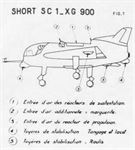Фотографии
-
Регистрационный номер: XG900 [2] Shorts designed and built two prototypes - XG900 and XG905 - of the S.C.1 experimental jet-powered vertical take-off and landing (VTOL) aircraft, fitted with four vertical-lift engines and one horizontally mounted for conventional flight. Both had completed transitional flights from vertical to horizontal flight by the end of 1960.
The first SC.1 prototype, XG900, being flown by Tom Brooke-Smith at the SBAC show at Farnborough in 1961. It was in this machine that French pilots got their first experience of VTOL flight.Самолёты на фотографии: Short SC.1 - Великобритания - 1957
-
Only two SC.1s were built, the second, XG905, crashing in October 1963, killing its pilot J.R. Green. It was rebuilt, however, and both aircraft undertook trials until 1971, XG900 going to the Science Museum and XG905 to the Ulster Folk & Transport Museum in Northern Ireland. Both remain on display today
Самолёты на фотографии: Short SC.1 - Великобритания - 1957
-
Регистрационный номер: XG900 [2] In April 1961 XG900 was handed over by Short Bros to the Royal Aircraft Establishment (RAE) at Bedford, where it was used the following July by the French team to get “hands-on” experience of VTOL operations. Both SC.1s remained in bare-metal, although Dayglo orange panels were added to the wingtips and rudder of both.
Самолёты на фотографии: Short SC.1 - Великобритания - 1957
-
Views to the port, centre and starboard sides of a mock-up of the SC.1 cockpit. The late John Farley, who flew both the P.1127 and SC.1 at Bedford, recalled of the SC.1: “The pilot was essentially operating a five-engined aircraft solo; one which incorporated none of the benefits of automation that would be available today, leaving the pilot with five of most things to deal with when it came to [flying the machine]”.
Самолёты на фотографии: Short SC.1 - Великобритания - 1957
-
A contemporary illustration of the cockpit and pilot’s position of the SC.1, the forward end of which incorporated extensive glazing, offering the pilot a good view forward and downwards. Instrumentation and controls were laid out with everything close to hand, although Bigand and Pinier noted that shorter pilots may find some of the controls, especially the lift-engine throttles, hard to reach.
Самолёты на фотографии: Short SC.1 - Великобритания - 1957
-
A French illustration of the pit concept preferred by the Dassault/CEV team for its greater ease of operation, the alternative raised-platform concept increasing hazard and workload for the pilot. Here the SC.1 is positioned over the duct; the hot gases from the engines were then channeled rearwards and exhausted aft of the airframe.
Самолёты на фотографии: Short SC.1 - Великобритания - 1957
-
Another of the French SC.1 illustrations, this time showing the aircraft’s various propulsion and stabilisation elements. The key runs as follows: 1) lift-engine intakes; 2) auxiliary air intake and “daisy” (i.e. petal-style) louvre-doors for the lift engines; 3) propulsion engine air intake; 4) pitch and yaw stabiliser nozzles; 5) roll stabiliser nozzles.
Самолёты на фотографии: Short SC.1 - Великобритания - 1957
-
The leading particulars and three-view of the Short SC.1 as provided in the French report on the type in 1962. The profile and head-on views show the aircraft in forward-flight configuration, and the plan view the hovering/slow
flight configuration.Самолёты на фотографии: Short SC.1 - Великобритания - 1957
-
«Бальзак» перед началом полетов на привязи. Октябрь 1962 г.
The Balzac V was a joint venture between Dassault and Sud Aviation and incorporated eight 2,160lb (9·6kN)-thrust Rolls-Royce RB.108-1A turbojets for lift and one Bristol Siddeley Orpheus BOr.3 turbojet for forward propulsion. The sole prototype made its first tethered hover flight in October 1962 with Rene Bigand at the controls.Самолёты на фотографии: Dassault Balzac - Франция - 1962
-
Самолёты на фотографии: Dassault MD-610 Cavalier - Франция - 1960
-
The “double-delta” X-600, almost certainly inspired by Saab’s J 35 Draken of 1955, was to be powered by a combination of six Rolls-Royce RB.162 vertically mounted turbojets for direct lift and one Rolls-Royce/MAN RB.153 turbofan for forward propulsion
Самолёты на фотографии: Sud-Aviation X-600 - Франция - 1959
Статьи
- -
- B.Cahill - Ghost Fortresses of the Apocalypse (1)
- C.Gibson - Beyond Black Buck?
- D.Stringer - Around the world in 28 days!
- I.Bott, M.Bone - Hell's teeth!
- J.-C.Carbonel - Adventures francaises en VTOL
- J.Ford - The case for the Scimitar
- K.Hayward - The De Havilland Comet & the British Government. Back in business (3)
- L.Andersson - Fall of the Phoenix
- M.Wickstead - French wings over five continents. The story of UTA (1)
- P.Davidson - Off the Beaten Track...
- P.Jarrett - Lost & Found
- P.Lewis - Switzerland & the Swashbuckler
- R.Forsyth, A.Dillmann - Eyes of the Luftwaffe (2)
- T.Jenkins - Guts, No Glory










